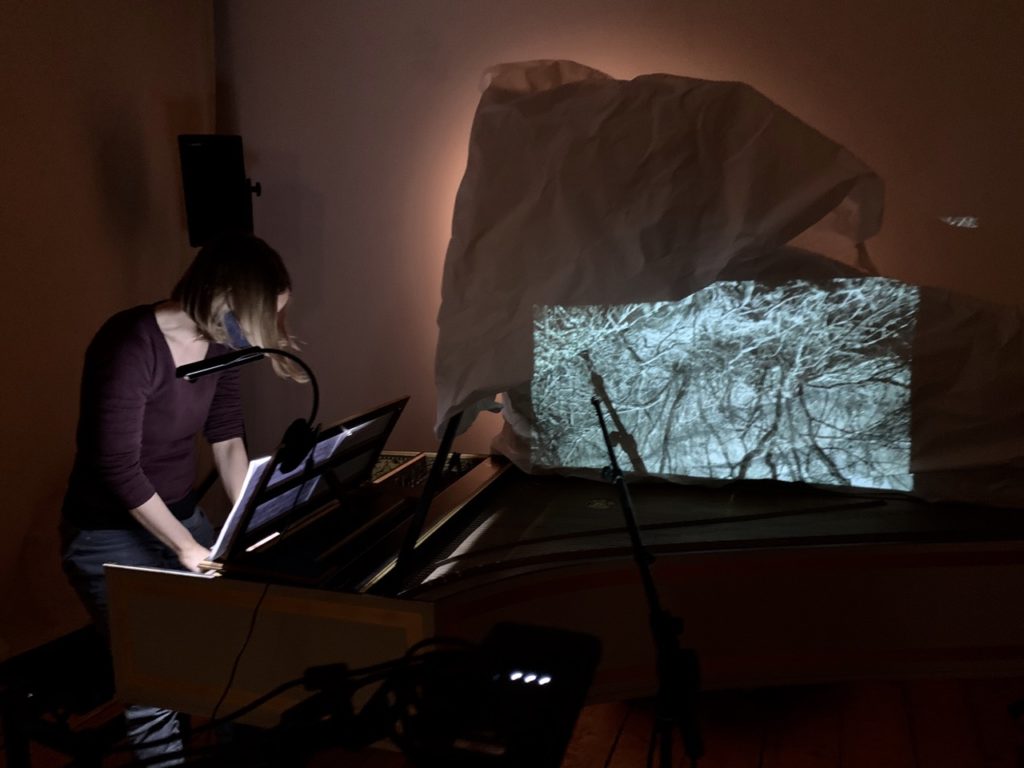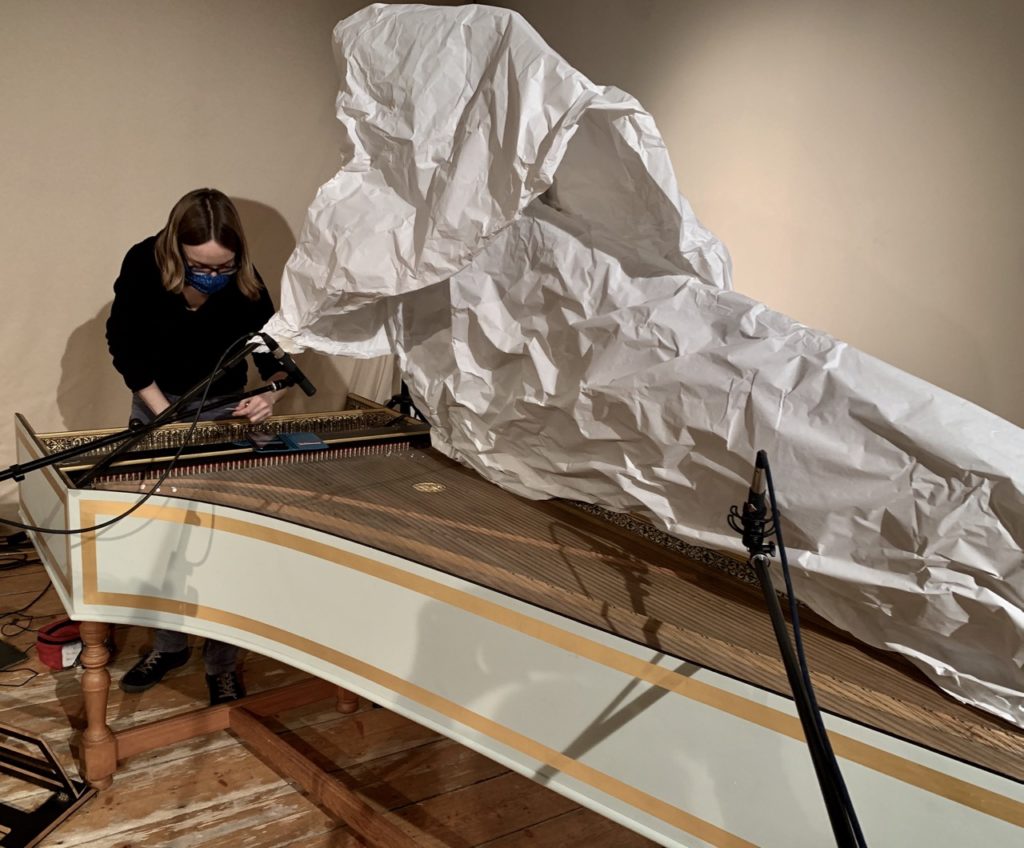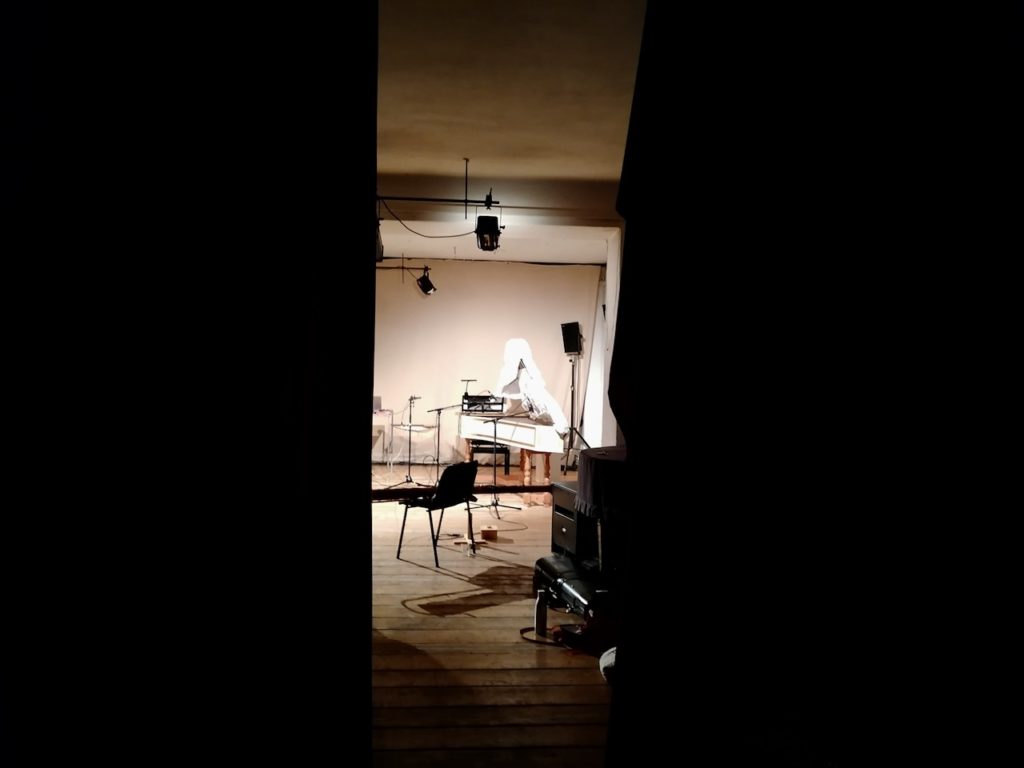a piece for harpsichord
with microtonal tuning and preparations
version #4 (2021) with video
First performed in January 2021 by Sonja Leipold at echoraum Vienna, recorded and filmed by echoraeume Vienna during a streaming concert. Thanks to by echoraum Wien for supporting the performance.
Photos by Palme & Maierhofer-Lischka, video by echoraeume.
This paper by Pia Palme was commissioned by KNM’s Salon #2 Tunings of the World 2.0 – Historical Instruments in Contemporary Music and explores the conception and making of the piece.
KREIDEBLEICH. Harpsichord performance as music theatre.
KREIDEBLEICH is a long term project for harpsichord solo that began early in 2019 in collaboration with the Viennese performer Sonja Leipold. Her virtuosity, her expertise in using preparations, and her proficiency in extending techniques inspired this exploration; collaborative experimentation sparked new ideas.
Themes and narratives
KREIDEBLEICH is a German word and means ‘white as chalk’. The initial idea for this piece appeared to me during a residency on the Finnish island Örö in the Baltic Sea, in November 2018. In those Northern terrains, the light is special at the beginning of winter. The days are short with the sun barely rising above the horizon. After sunset, the afterglow continues for a long time; over the water, the sky gleams from within with a chalky radiance. To me, coming from central Europe, this kind of light appears unreal, strange and vexing – it makes me restless, I have to wander out into the open, towards the sea, to breathe in the rays of this feeble glow, as long as I can.
At that hour, the flow of time itself comes to a halt. A gap appears in life. The very moment hesitates to leave, the present lingers on and refuses to vanish into the darkness of the past. I envision a pale human creature slowly walking along the shoreline, a woman beyond age, she reluctantly drags along her endless whitish garments, rustling over pebbles, sand, and seaweed. A former empress vanishing, as fragile as her own shadows. Memories and futures begin to dance together on the shore, brushing over the ground. Silvery water splashes, waves curling. With my inner ear I hear the harpsichord, as the figures swirl around, faster and faster. Finally, darkness approaches.
This is the thematic background of the piece. Why does the harpsichord emerge in this context? It is a historic instrument from the Baroque period; its construction is light and flexible. The sound of the instrument does appear silvery and timeless to me, so that is one reason. Furthermore, the potential to selectively tune its choirs is a distinguishing factor. The body is made entirely from wood and the strings are quickly tuned. In Baroque music, that was necessary, because tuning systems differed widely. As we know from Bach’s work, for example, composers experimented with tuning systems and preferred particular tunings for their music. At that time, all instruments had to be flexible as far as tuning was concerned. In this way, the construction of the harpsichord differs from the construction of the piano: the piano is designed to hold a stable, uniform pitch.
The instrument in use for the video recording was a two-manual French harpsichord, 5 octaves, with the disposition 8’8’4’ plus a lute stop. We worked with a microtonal scordatura that consisted of a 443 Hz equal temperament for the 8’ on the upper manual and for the 4’ on the lower manual; the 8’ on the lower manual was tuned a quarter tone down. Such a microtonal scordatura provides a rich and dense pitch reservoir that allows me to sonify all the nuances of pale shimmer and oscillation that I have in mind. Detuning one of three choirs makes it possible to combine choirs and microtonal pitches in various ways, to modify timbral colours and achieve sonic complexity. We also employed several damping techniques (using paper, pieces of fabric, and hands) and a pedal effect produced with a wood block of a certain length that was installed on the keys in a low octave. Further objects we used include a drinking glass, small blocks of wood, a glass cylinder, long fibres attached to the lowest strings, pieces of rubber (from a bicycle tire), and brushes.
Dramaturgies of sound and sight
What attracts me to the Baroque period is its acute awareness of space and theatricality that pervades all the arts, including music and composition. I experience Baroque music as physical and spatial, both in performing as well as in composing and listening. There is a sense of how things are to be arranged in space, according to well defined structures and concepts. Sceneries are being created. The harpsichord is a good example of that: it is a theatre in itself. As the main keybord instrument of the period, it visually dominates a stage. When its lid is fully opened, the sound is directed up and towards one side, towards the audience. However, sound is also emitted from the bottom of instrument, mainly the lower and more percussive, noisy ranges of frequencies. These frequencies travel along the wooden floors of the concert space, and thus add further depth and sonority to the overall spectrum. During a studio recording last year, I tried this out with a sound technician, when we microfoned the instrument. This may be similar to the piano, but in the Baroque time this was all new and exciting – the harpsichord was a novel instrument then. I have a strong connection to Baroque music and performance practice, which I studied, being a professional recorder player. I’m also an electronic musician, and in electronic music a sense of space is important when it comes to the amplification and directionality of sounds. Both fields of experience come together in my work.
Back to the harpsichord and its unique potential: on the stage, the harpsichord would be positioned behind the soloist, in the background. Thus, the instrument supports and embraces the soloist, visually as well as aurally. The sound of the harpsichord opens up a sonic space with a wide stereo angle – as we would say now. Since the instrument is further away from the audience, there is a greater delay in connection with the sound, for the listener. The soloist, from a position closer to the audience, appears as a more present, direct and central source of sound – more like a nearer mono source. In this way, a particular dramaturgy of sound and sight is created.
Aspects of the composition
Formally, the piece is modelled as a chaconne with irregularities. The chaconne is a musical form that features continuous variations of a short progression; once more, I pay homage to the Baroque period and to works by composers such as François Couperin or Jean-Baptiste Lully. In my piece, a progression of measures [5/4 4/4 3/4 3/8 4/4] serves as a rhythmic ostinato unit that is repeated, with certain deviations. Sonic variation is also something I play with, there is a certain pool of clusters and pitch combinations that reoccur. The form of the chaconne gives me the freedom to navigate the timbral palette of Leipold’s technique by approaching ideas from several compositional angles. I draw on Baroque harpsichord timbres and techniques, such as trills and tremolos, and various forms of arpeggios, all with variations of tempo. What attracts me compositionally is that in Baroque music, trills and tremolos are considered as timbral elements in a piece, that is, changes of colour. For passages with a rich, complex, and dense sound, I use quarter tone clusters using both manuals. Only through varying the density of sound one can vary – or create the illusion of varying – the volume of harpsichord music. (The volume of the sound itself cannot be varied with the keys, because the strings are being plucked, mechanically.) There are rhythmic passages and more ambient, fluid modules in the piece. They may be repeated, varied or structured in multiple ways. Thus, the performer has the freedom to assemble a specific progression for a particular performance situation.
The theatricality of harpsichord performance
The harpsichord is more than an instrument, it is a piece of furniture and a receptacle for visual art and painting. The lid inside was often decorated with a picture of a rural scenery, a view onto a garden or towards a natural landscape – in short, the open lid would evoke a sense of a distant wider space, serving as a scenery for the music and soloists. We find harpsichords “bearing works by masters as renowned as Jan Brueghel, Annibale Carracci, Noël Coypel, Christophe Huet, or Sebastiano Ricci” – here, I refer to the lecture The Art of the Harpsichord: Music and Painting [held 2018 at the National Gallery of Art in Washington, DC, available at https://www.nga.gov/audio-video/video/laloue-harpsichord.html] by Christine Laloue, chief curator of harpsichords and fine arts of the Musée de la musique in the Cité de la musique – Philharmonie de Paris. She shows some fine examples of lid paintings to illustrate that the harpsichord was a “symbol of artistic inspiration” and “indeed a total work of art” (Laloue, 2018). To extend further, I propose that the art of harpsichord performance is music theatre. This is even more so in contemporary harpsichord performance – in particular, if the performance is extended with new techniques and preparations. Sonja Leipold turns the inside space of the harpsichord into a second instrument rich in timbral colours. As she moves her fingers, hands, arms and objects, and her entire body across the various spaces of the instrument, musical performance becomes a gestural and theatrical process.
My idea was to revive and enhance the conception of the lid painting with using a video projection. I experimented with white (stage-proof) paper to cover the lid for better reflection, and I found that a crumpled surface adds three-dimensionality to the projection. Plus, through crumpling I could sculpt the paper into what looked like a model of a grotto, with the film appearing ‘inside’ – truly a miniature stage. The video shows nature scenes: the material was filmed in Finland and Canada and is digitally processed. The visual directly relates to the music, because it shows the very places of inspiration for my piece.
To conclude, KREIDEBLEICH is a piece that brings together memories from the past with ideas from the present, weaving them into personal narratives, to speculate about the future. Sound, sight, and movement interrelate and summon a theatrical dramaturgy around musical performance.



